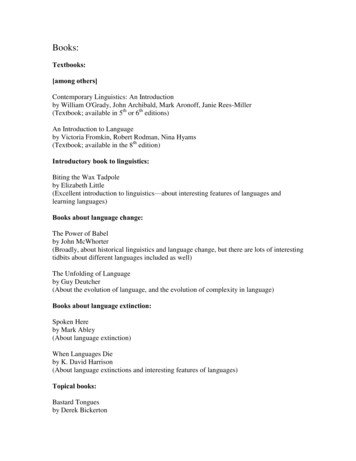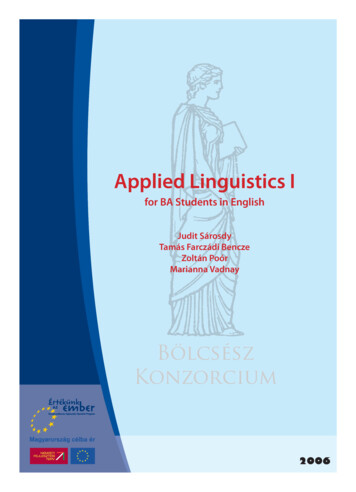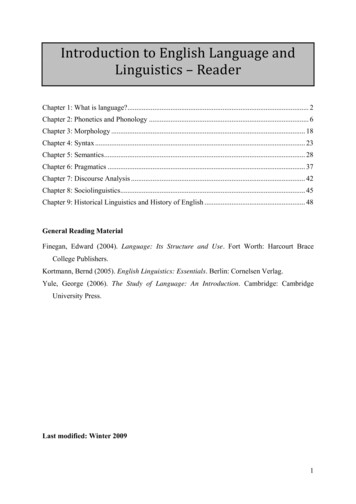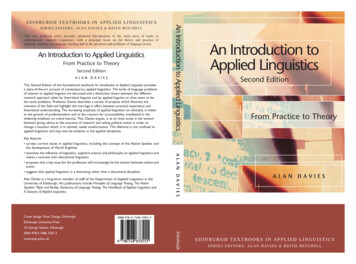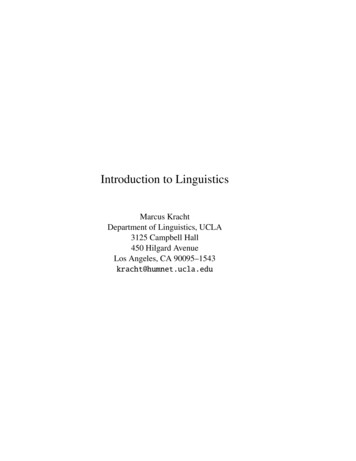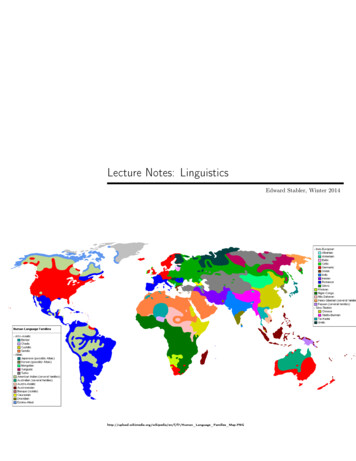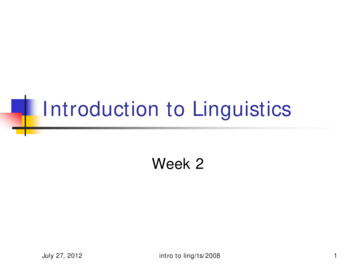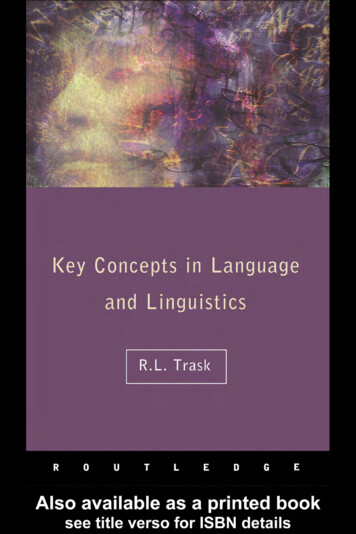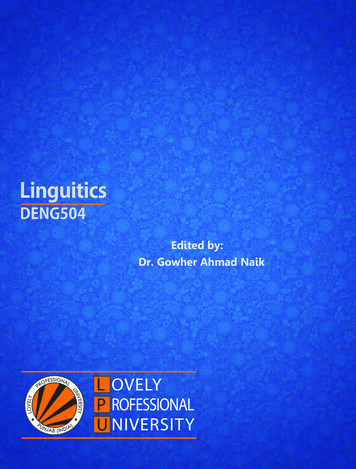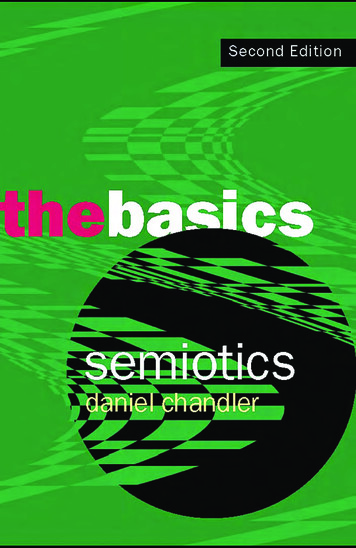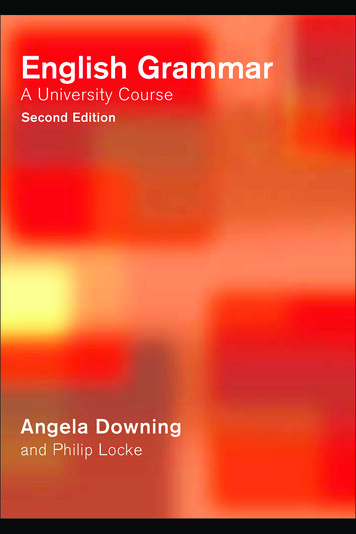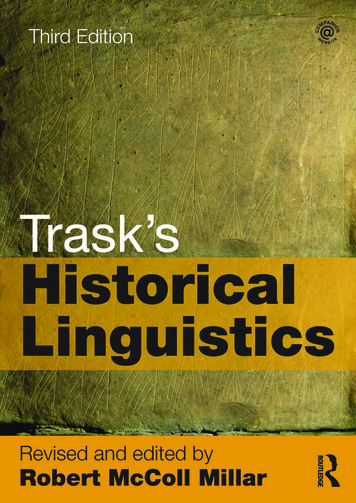
Transcription
Trask’s Historical LinguisticsTrask’s Historical Linguistics, Third Edition, is an accessible introduction to historicallinguistics – the study of language change over time. This engaging book is illustrated withlanguage examples from all six continents, and covers the fundamental concepts of languagechange, methods for historical linguistics, linguistic reconstruction, sociolinguistic aspectsof language change, language contact, the birth and death of languages, language andprehistory and the issue of very remote relations.This third edition of the renowned Trask’s Historical Linguistics is fully revised andupdated and covers the most recent developments in historical linguistics, including:䊉䊉䊉䊉more detail on morphological change including cutting-edge discussions of iconizationcoverage of recent developments in sociolinguistic explanations of variation and changenew case studies focusing on Germanic languages and American and New ZealandEnglish, and updated exercises covering each of the topics within the booka brand new companion website featuring material for both professors and students,including discussion questions and exercises as well as discussions of the exerciseswithin the book.Trask’s Historical Linguistics is essential reading for all students of language, linguisticsand related disciplines.The accompanying website can be found at www.routledge.com/cw/traskRobert McColl Millar is Professor in Linguistics and Scottish Language at the Universityof Aberdeen. His most recent books include English Historical Sociolinguistics (2012)and (with William Barras and Lisa Marie Bonnici) Lexical Variation and Attrition in theScottish Fishing Communities (2014).Larry Trask was Professor of Linguistics at the University of Sussex and an authority onBasque language and historical linguistics.
‘Trask’s Historical Linguistics is a jewel among textbooks of Historical Linguistics: it bringsto life the intriguing paths on which human languages have wandered in their development,and sparks the enthusiasm of the reader to explore and study them, providing the necessarytoolkit and background knowledge.’Robert Mailhammer, University of Western Sydney, Australia‘Larry Trask’s Historical Linguistics is an exemplary introduction to the field, and McCollMillar’s third edition is a much needed update: the new case studies and exercises aresuperb, and the revised reading suggestions extremely helpful.’Adrian Pablé, University of Hong Kong‘This new edition of Trask’s Historical Linguistics by Robert McColl Millar provides athorough introduction to the field in the broadest sense while remaining accessible to students and specialists alike. Truly a useful book.’Garry Davis, University of Wisconsin-Milwaukee, USA‘This revised and expanded edition of Trask’s seminal work will make welcome readingfor scholars and students alike.’Raymond Hickey, University of Duisburg and Essen, Germany‘Accessible but not simplified, entertaining but not simplistic, this book provides thoroughcoverage of the field with a richness of explanation and examples that offers at the sametime a synthetic overview and a wealth of data and detail. The new companion websitepromises to enhance its value as a textbook for the classroom and the independent learner.’Mark Richard Lauersdorf, University of Kentucky, USA
Trask’s Historical Linguistics3 rd EditionEdited byRobert McColl Millar
Third edition published 2015by Routledge2 Park Square, Milton Park, Abingdon, Oxon OX14 4RNand by Routledge711 Third Avenue, New York, NY 10017Routledge is an imprint of the Taylor & Francis Group, an informa business 2015 Robert McColl Millar and Larry TraskThe right of Robert McColl Millar and the late Larry Trask to be identified as authors of this work has beenasserted in accordance with sections 77 and 78 of the Copyright, Designs and Patents Act 1988.All rights reserved. No part of this book may be reprinted or reproduced or utilized in any form or byany electronic, mechanical, or other means, now known or hereafter invented, including photocopying andrecording, or in any information storage or retrieval system, without permission in writing from thepublishers.Trademark notice: Product or corporate names may be trademarks or registered trademarks, and are usedonly for identification and explanation without intent to infringe.First edition published as Historical Linguistics by Arnold 1996Second edition published by Hodder Education 2007British Library Cataloguing-in-Publication DataA catalogue record for this book is available from the British LibraryLibrary of Congress Cataloging-in-Publication DataTrask’s historical linguistics. – Third Edition. / edited by Robert McColl Millar.p. cm.Rev. ed. of: Trask’s Historical linguistics / R.L. Trask. London : Arnold, 2007.Includes bibliographical references and index.1. Historical linguistics. 2. Comparative linguistics. I. Millar, Robert McColl, 1966(Robert Lawrence), 1944–2004. Historical linguistics. III. Title.P140.T74 2015Proudly sourced and uploaded by [StormRG]417’.7–dc23Kickass Torrents TPB ET h33tII. Trask, R. L.2014031176ISBN: 978-0-415-70657-5 (hbk)ISBN: 978-0-415-70658-2 (pbk)ISBN: 978-1-315-72805-6 (ebk)Typeset in Times New Romanby Graphicraft Limited, Hong KongAdditional materials are available on the companion website at www.routledge.com/cw/trask
ContentsList of illustrationsTo the readerTo the teacherAcknowledgementsAbbreviations1 The fact of language change1.1 Chilled1.2 English then and now1.3 Attitudes to language change1.4 The inevitability of changeCase study: bonk!Further readingExercises2 Lexical and semantic change2.1 Borrowing2.2 Phonological treatment of loans2.3 Morphological treatment of loans2.4 Formation of new words2.5 Change in word-meaningCase study: niceFurther readingExercises3 Phonological change I: change in pronunciation3.13.23.33.4The phonetic basis of phonological changeAssimilation and dissimilationLenition and fortitionAddition and removal of phonetic 44444848495155
viContents3.5 Vowels and syllable structure3.6 Whole-segment processes3.7 The regularity issue: a first lookCase study: Germanic */xw/ in the present-day dialects3.8 SummaryFurther readingExercises576062636666674 Phonological change II: change in phonological systems714.1 Conditioning and rephonologization4.2 Phonological space4.3 Chain shifts4.4 Phonological change as rule changeCase study: the Germanic consonant system: ‘Grimm’s Law’ and‘Verner’s Law’4.5 SummaryFurther readingExercises5 Morphological change5.1 Reanalysis5.2 Analogy and levelling5.3 Universal principles of analogy5.4 Morphologization5.5 Morphologization of phonological rules5.6 Change in morphological typeCase study: the development of the definite article from thedemonstrative paradigm in EnglishFurther readingExercises6 Syntactic change6.1 Reanalysis of surface structure6.2 Shift of markedness6.3 Grammaticalization6.4 Typological harmony6.5 Syntactic change as restructuring of grammarsCase study: the rise of ergativityFurther 118122122126126131134137140143148149
Contents7 Relatedness between languages7.1 The origin of dialects7.2 Dialect geography7.3 Genetic relationships7.4 Tree model and wave model7.5 The language families of the worldCase study: a Martian’s eye view on the Germanic language familyFurther readingExercises8 The comparative method8.1 Systematic correspondences8.2 Comparative reconstruction8.3 Pitfalls and limitations8.4 The Neogrammarian Hypothesis8.5 Semantic reconstruction8.6 The use of typology and universals8.7 Reconstructing grammar8.8 The reality of proto-languagesCase study: a reconstruction too far?Further readingExercises9 Internal reconstruction9.1 A first look at the internal method9.2 Alternations and internal reconstruction9.3 Internal reconstruction of grammar and lexiconCase study: the laryngeal theory of PIEFurther readingExercises10 The origin and propagation of change10.1 The Saussurean paradox10.2 Variation and social stratification10.3 Variation as the vehicle of change10.4 Lexical diffusion10.5 Near-mergersCase study: historical sociolinguistics10.6 A closing noteFurther 247250250251257271275278282284285
viii Contents11 Social and historical pressures upon language11.1 Linguistic contact11.2 Linguistic areas11.3 Language birth: pidgins and creoles11.4 Language planning11.5 Language deathCase study: the genesis and development of American andNew Zealand EnglishFurther readingExercises12 Language and prehistory29129130330431131932633533634312.1 Introduction12.2 Linguistic palaeontology12.3 Links with archaeology12.4 Statistical methodsCase study: Greenberg’s mass comparisonFurther readingExercises343343345350359365365Appendix: the Swadesh 200-word listBibliographyIndex370372386
.610.710.811.112.112.212.3Primary splitThe phoneme system of Modern GreekThe English Great Vowel ShiftThe history of the Greek vowel systemA Mojave copular sentenceThe past tense of dive in the eastern USA (Atwood 1953: Figure 6)The past tense of see in England (Upton et al. 1987: map 139)An isogloss bundle in France (Chambers and Trudgill 1980: map 7.6)The major dialect areas of England (Trudgill 1999: map 9)The dialect areas of the eastern USA (Kurath and McDavid 1961: map 2)The Germanic family treeThe Indo-European family treeA wave diagram of the Germanic family (developed from Robinson 1992)A Martian Germanic family treeThe local words for ‘young dog’ in England (Upton et al. 1987)Part of the us/uns isogloss boundaryFrench words for ‘mare’ (Dauzat 1922)Uvular /r/ in Western EuropeThe variable (ng) in Norwich (adapted from Trudgill 1974)The variable (r) in New York City (adapted from Labov 1972)(th) in Belfast (adapted from Milroy 1987)Multiple negation in early Modern English 1 (adapted from Nevalainenand Raumolin-Brunberg 2003: 72)The S-curveMultiple negation in Early Modern English (adapted from Nevalainenand Raumolin-Brunberg 2003: 146)Four New York vowel systems (Labov 1994: 203)Spanish ch in Panama City (adapted from Cedergren 1973, 1984 andLabov 1994)Sasse’s model of language shift (Sasse 1992: 19)Proposals for the Indo-European homelandA nomograph of the Lees equationA revised tree for 3187188189190259259266281281282287288322346354357
xIllustrations12.412.5A conventional family tree of GermanicA reticulated family tree of Germanic (McMahon and McMahon 2005:152, Figure 8.48.58.68.78.88.98.108.118.12Some inflectional patterns of German nounsThe treatment of loan words in GermanLatin /c/ and /g/ in words borrowed by BasqueSummary of whole-segment processesOE long vowels and their historyLatin /k/ in varieties of SpanishSound change in YinwumThe split of Old English /k/The split of Latin /s/Rule reordering in Bizkaian BasqueConsonant correspondences between Germanic and other IE varieties(adapted from Hock and Joseph 1996: 115)Verner’s Law and Sanskrit stress (adapted from Hock and Joseph 1996:119)Vowel patterns in Zuberoan and other Basque dialectsThe consonants of proto-Polynesian and Hawaiian (adapted fromCrowley 1992)The ‘Northern Cities Shift’ (adapted from Labov 1994)Analogical levelling in FrenchSome Old English inflectionsParadigm for the simple demonstratives in late West SaxonOld English personal pronoun paradigmsVerbal morphology in early IE varietiesThird person singular personal pronoun paradigms in early GermanicvarietiesAgreement morphs in Basque (adapted from de Rijk 1995)Shift in main-clause syntax in biblical Hebrew (adapted from Givón 1977)The Spanish futureGreenberg’s word-order typesA comparison of three languagesA systematic correspondenceFurther systematic correspondencesWestern RomanceCorrespondences involving voiceless plosivesCorrespondences involving voiced plosivesCorrespondences involving nasalsCorrespondences involving fricativesCorrespondences involving liquidsProto-Western-RomanceAlgonquian, Yurok and WiyotA 205
Illustrations8.138.148.158.16Another pitfallAn unexpected problemThe inflection of PIE *pēs ‘foot’Some Nostratic correspondences (adapted from Kaiser and Sherovshkin1988)8.17Some demonstrative paradigms in early IE varieties8.18Turkic monosyllabic nouns with suffixes: a comparison (adapted fromHahn 1991)8.19Correspondences between two closely related Papuan languages (adaptedfrom Gregerson and Hartzler 1987)8.20Comparative Basque dialect forms8.21Comparative Slavonic reconstruction (Russian)8.22Comparative Slavonic reconstruction (Czech)8.23Comparative Slavonic reconstruction (Serbo-Croatian)9.1Voicing alternations in German9.2Final devoicing in German9.3Nominative and genitive in ancient Greek9.4The history of Greek nominatives9.5Vowel alternations in Old English9.6Some typical PIE roots9.7Some exceptional PIE roots9.8Some typical Māori verbs9.9Some typical proto-Germanic verb forms9.10Definite articles and noun forms in Basque9.11Welsh initial mutation10.1CIs and age (adapted from Labov 1972)10.2CIs and occupation (adapted from Labov 1972)10.3CIs and geography (adapted from Labov 1972)10.4CIs and ethnic group (adapted from Labov 1972)10.5CIs and attitude to the island (adapted from Labov 1972)10.6The variable (ng) in Norwich (percentages of –in forms) (adapted fromTrudgill 1974)10.7Percentage of informants over- and under-reporting (yu) (adapted fromTrudgill 1975: 95)10.8Percentage of informants over- and under-reporting (er) (adapted fromTrudgill 1975: 96)10.9 aVe and ea pronunciations in Belfast (adapted from Harris 1980)10.10 Use of non-standard variant (%) (adapted from Ash and Myhill 1986)10.11 Variation in word pronunciation in Skikun (adapted from Li 1982)11.1Old Armenian case-inflection11.2Modern Armenian case-inflection11.3Turkish case-inflection11.4Word order in Ethiopian Semitic languages11.5Comparison between Old Norse and modern Norwegian11.6The names of four chemical elements12.1Swadesh word-lists for English, French and 5286288296296297298300318367
To the readerThis book is intended to give you an introduction to historical linguistics. It deals with thestudy of the histories and prehistories of languages, with the discovery of ancient connections between languages, and with the study of language change. Historical linguistics hasexisted as a scholarly discipline for well over 200 years, and it was the first branch oflinguistics to be placed on a firm scholarly footing; nonetheless, it is at present one of theliveliest and most engaging areas of linguistics. The subject has recently been revolutionized by the sociolinguistic examination of variation and change, and today, unlike ourpredecessors, we can watch a language changing in front of our eyes (or, perhaps better,hear it changing in front of our ears). Progress in other areas of linguistics, such as thestudy of typology and universals and the study of syntax, has had a profound effect on ourdiscipline, by opening up new avenues for exploration. Our traditional links with archaeology have recently been renewed in dramatic fashion, and some of us are beginning to lookat possible links with such unexpected fields as genetics and physical anthropology. In thepast two decades, exciting and controversial new hypotheses have turned up in the pagesof our journals and attracted heated discussion. At the same time, new statistical and computational methods are being brought to bear on some of our outstanding problems. All ofthese developments are explained in the pages of this book.The book is designed to be used with an instructor on a university course in the subject,but it can equally be read with pleasure and understanding by anyone interested in findingout something about how and why languages change, what the consequences of changeare, and how we go about the business of uncovering the prehistories of languages and offamilies of languages.To get the most out of this textbook, you will find it extremely helpful (and, if you’re astudent, essential) to consult certain reference books. Chief among these is the OxfordEnglish Dictionary, the great dictionary of English that covers the last thousand years ofthe language. Most libraries will possess the OED, either on paper or on the web, and youshould become familiar with it and learn how to use it. You will also find it useful toconsult one of the etymological dictionaries of English: Onions (1966), Partridge (1966)or Klein (1971); your library will probably have at least one of these. It will not be necessary to consult etymological dictionaries of other languages, but, if you can read therelevant languages, you will find it illuminating to browse through Corominas and Pascual(1980) for Spanish (written in Spanish), Ernout and Meillet (1959) for Latin (written inFrench), Meyer-Lübke (1935) for the Romance languages (written in German) or Pokorny(1959) for Indo-European, the vast family to which English belongs (written in German).
To the readerxiiiAnd, if your library has it, you should certainly become acquainted with Buck (1949),which is a treasure trove of information about the vocabularies of most of the major IndoEuropean languages; this book is written in English. A recent, and generally excellent,introduction can be found in Mallory and Adams (2006).Every chapter in this book contains suggestions for further reading on the topics coveredin that chapter, and you would be wise to chase up and read some of the books and articlessuggested for those topics that particularly interest you. With just a few exceptions, all thereferences are to work written in English, and nearly all this work is reasonably easy toread. You will also find exercises at the end of each chapter. Along with other material,these are discussed further on the book’s dedicated website at www.routledge.com/cw/trask.
To the teacherThis is a textbook of historical linguistics, designed to be used with a ten- to fifteen-weekcourse in the subject with university students meeting it for the first time. Students willneed to have some background in basic descriptive linguistics: specifically, they will needsome acquaintance with phonetics, with the (classical) phoneme concept and with a littlemorphology. They will also require some grasp of traditional grammar, at least with theparts of speech and with notions such as ‘sentence’, ‘transitive verb’, ‘subordinate clause’and ‘direct object’.The book is as atheoretical as possible: absolutely no knowledge of contemporary theoriesof phonology or syntax is presupposed, and such theories are not introduced in the book.Some acquaintance with the notation of classical generative phonology will be helpful forChapter 3, but is not essential. The only theories introduced here are theories of historicallinguistics and of language change.The organization is as follows. The book opens with a demonstration of the fact oflanguage change, using data that will or may be familiar to the students. Next, it discusseslexical and semantic change, the types of change that are most readily visible. Succeedingchapters cover phonological change (syntagmatic and paradigmatic), morphological changeand syntactic change. Chapter 7 then addresses the consequences of language change, inthe form of dialects and language families. With an understanding of language change andits consequences, students should then be ready to tackle the next two chapters, dealingwith the principal historical methods and particularly with reconstruction. Chapters 10 and11 deal with sociolinguistic issues, the first with the relation between variation and change,the second with contact, the birth and death of languages and language planning. Chapter12 examines a variety of issues in language and prehistory, connections with archaeologyand recent statistical approaches.No attempt is made to cover every conceivable topic in historical linguistics. Instead,the book concentrates on presenting the most central issues as clearly and illuminatinglyas possible, together with a representative sample of other topics which I consider particularly interesting. Abundant further reading is suggested for every topic discussed.Especially in the earlier chapters, English data are used wherever possible, in order toencourage students to relate their own knowledge and experience to the content of thebook. Some considerable use is also made of French, Spanish, German and Italian, thesecond languages most likely to be known by English-speaking students. Exceptionallyfrequent are data from Basque, a language that rarely features in textbooks. But the bookultimately makes use of data from a wide range of Indo-European and non-Indo-Europeanlanguages from all six inhabited continents and the islands of the Pacific. The ancient Indo-
To the teacherxvEuropean languages figure less prominently here than in some other textbooks, but theyare not neglected, and considerable attention is paid to Proto-Indo-European.A prominent characteristic of this book is its insistence on combining the study of ancientlanguages with the study of contemporary change. So, a discussion of what happened inLatin or Old English centuries or millennia ago will frequently be found next to a discussion of what’s going on in English or French at the moment. I believe strongly that studentsshould grasp the idea that language change today is not significantly different from languagechange in the remote past: we may require different techniques for studying the two cases,but the phenomena are the same. Too many other textbooks, in my view, treat the studyof historical linguistics as the study of mouldering museum pieces; I want the reader, oncein a while at least, to read a paragraph and exclaim ‘Hey – I know something about that!’I have therefore made every effort to avoid reducing students to passive spectators watching a train of dry facts parade majestically past their noses, and to persuade them insteadthat language change is something they are personally involved in.Every chapter is accompanied by a set of original exercises. These are usually arrangedfrom easiest to hardest and most time-consuming, so that instructors can select exercisesaccording to the level of their course and the amount of time available. Discussion ofexercises and other issues is on the book’s dedicated website at www.routledge.com/cw/trask.The last four chapters are self-contained, and teachers will be able, if they like, to pickand choose among them according to the nature of the course they want to teach.In comparison with most other textbooks, this one devotes an unusually large amountof space to etymology and onomastics, to the recent work on syntactic change, to thecontribution of the sociolinguists, to language birth and death, to language planning andto the often controversial use of statistical methods and the establishment of distant languagerelationships. It is further distinguished by its explicit discussion of how not to do historicallinguistics.
AcknowledgementsThis third revision of Trask’s Historical Linguistics was carried out in 2013 and 2014,partly during research leave kindly awarded by the School of Language & Literature at theUniversity of Aberdeen. I am very grateful to my colleagues at Aberdeen for shoulderingburdens so that I could do this and many other things with a minimum of disturbance;Andy Gordon should be given particular mention for taking on the role of School Directorof Teaching and Learning. Janet Cruickshank, Mercedes Durham, Elspeth Edelstein andHeike Pichler have all taught on courses where this book was required reading: WillBarras has discussed and helped clarify many of the issues raised; their input and feedbackhave been most helpful, as have, of course, the views of the many students to whom I havetaught historical linguistics. With the growth of social media I have also been able to takeinto consideration the views of students and others around the world. Reviewers andinterested correspondents have also been most helpful in pointing out occasional infelicitiesin the Second Edition. All of these have helped forge the Third Edition.The editorial staff at both Hodder Arnold and now Routledge have been very forgivingof my foibles. Nadia Seemungal and Helen Tredget in particular have exhibited considerable tolerance in the last stages of the new edition’s production.It is also important that I pay tribute to Larry Trask, a man I never met, much to myregret. While a considerable part of this book has been formed by me, the general conception is Larry Trask’s. I suspect that I would not have been as capable as he was inproducing such an impressive structure while not forgetting the small details so importantto its success.Finally, I would like to thank Sandra and Mairi, who put up with a lot because of mywork and the intensity which produces and lies behind it. This revision is dedicated tothem.PermissionsThe author and publisher would like to thank the following copyright holders for permission to reproduce the following material:Map from Atwood, E. Bagby (1953) A survey of verb forms in the eastern United States. University of Michigan Press. Reproduced with kind permission.Map from Upton, Clive, Sanderson, Stewart and Widdowson, John (1987) Word maps: adialect atlas of England. London: Croom Helm. Reproduced with kind permission ofTaylor & Francis.
AcknowledgementsxviiMap from Chambers, J. K. and Trudgill, Peter (1980) Dialectology. Cambridge University Press. Reproduced with kind permission.Figure from Trudgill, Peter (1999) The dialects of England. 2nd edn. Copyright 1999John Wiley and Sons. Reproduced with kind permission.Map from Kurath, Hans and McDavid, Raven I. (1961) The pronunciation of English inthe Atlantic States. University of Michigan Press. Reproduced with kind permission.Figure from Labov, William (1994) Principles of Linguistic Change, Volume I: InternalFactors. Copyright 1994 John Wiley and Sons. Reproduced with kind permission.Figure from Sasse, Hans-Jürgen (1992) Language decay and contact-induced change:similarities and differences. In Matthias Brenzinger (ed.), Language Death, pp. 59–80. 1992 Walter de Gruyter GmbH. Reproduced with kind permission.Excerpt from McMahon, April and McMahon, Robert (2005) Language classification bynumbers, Figure 6.8 from p. 152. By permission of Oxford University Press.Every effort has been made to contact copyright-holders. Please advise the publisher ofany errors or omissions, and these will be corrected in subsequent editions.
adjectiveabsolutive caseaccusative caseactive voiceAllomorphy Rule (in Natural Morphology)ArmenianaspectauxiliaryAvestanBizkaian dialect of BasqueBalto-SlavonicBasquepercentage of shared cognates (in glottochronology)Catalanany consonantcentralization indexcontinuantcopulacasual speechdative caseDéné-Caucasiandeclarative particledeterminerEnglishergative caseFrenchfeminine (gender)Frenchfrictionformal speechfuture tenseGipuzkoan dialect of Basquegenitive noun phrasegenitive caseGerman
undGreekGermanicGothicGreat Vowel ShiftHittiteHigh Navarrese dialect of BasqueIndo-Europeanimperfect aspectindicative moodIndo-IranianIrishItalianjussiveLapurdian dialect of BasqueLatinLithuanianmasculine (gender)Middle EnglishMiddle High GermanMorphophonological Rule (in Natural Morphology)nounnegativeneuter (gender)Natural Morphologynominative casenoun phraseobjectoblique caseOld Church SlavonicOld EnglishOld FrenchOld High GermanOld IrishOld Norseobject–subject–verb word orderobject-precedes-verb word orderobject–verb–subject word cipleProto-Dravidianperfect elianxix
xx ositional phrasePhonological Rule (in Natural Morphology)preposition(al)present tenseproper-name icProto-Western-Romanceglottochronological constantrealis moodRomanshReceived Pronunciationreading-passage ect–object–verb word orderSpanishsubjectsubject–verb–object word ordertime depth (in glottochronology)Tocharian Bany vowelVedic Sanskritverb-precedes-object word ordervoiceverb–object–subject word orderverb–subject–object word orderword-list speechZuberoan dialect of Basquefirst personsecond personthird person
Chapter 1The fact of language change1.1ChilledSome years ago I asked a friend whether she had had an enjoyable weekend. She repliedthat she had been ‘really chilled’. I immediately asked her whether she had been havingproblems with her central heating. When I saw the look of surprise and amusement on herface, I realized that the age difference between us (I was born in the 1960s, she in the1970s) had caused me to misunderstand her. To people whose formative years were thelate 1980s and early 1990s, chilled means ‘relaxed, peaceful’.I didn’t know chilled, but I did know chilled out, which had (and has) the same meaning.Because I am a child of punk, t
of Aberdeen. His most recent books include English Historical Sociolinguistics (2012) and (with William Barras and Lisa Marie Bonnici) Lexical Variation and Attrition in the Scottish Fishing Communities (2014). Larry Trask was Professor of Linguistics at the University of Sussex and an authority on Bas
